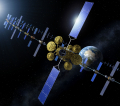Integrations made through European Space Agency's Pacis 3 project moves Spainsat NG closer to launch pad
10 Oct 2024
The European Space Agency's (ESA) Pacis 3 project took another step towards the launch pad, with the Direct Radiating Array Transmit (DRA TX) antenna and associated power supply unit and antenna control electronics recently delivered to Airbus Toulouse. These components were integrated on to the Spainsat NG1 satellite, a crucial element of the Spainsat second-generation programme for Spanish satellite operator Hisdesat.











